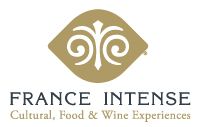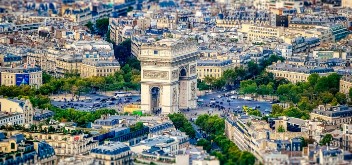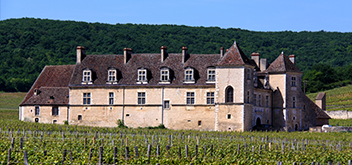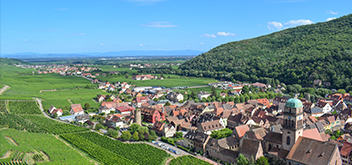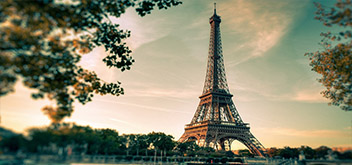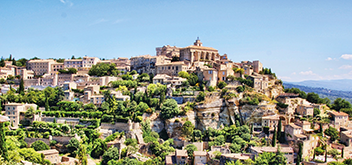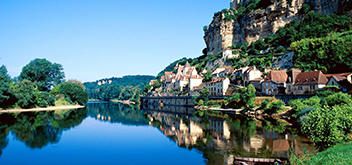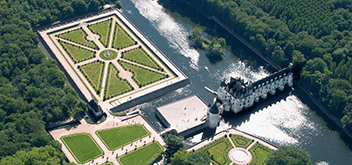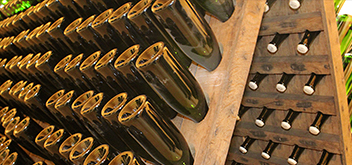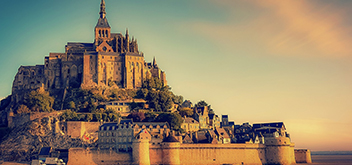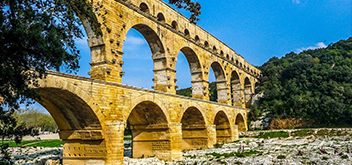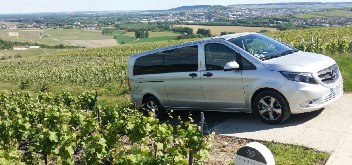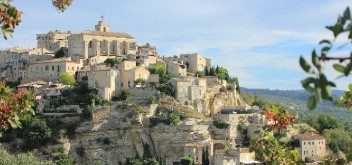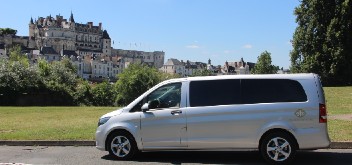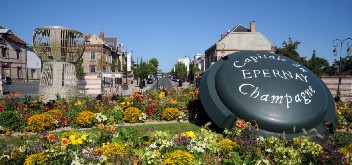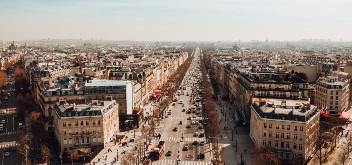No products
The scenic Route du Champagne
To discover the Champagne wines and the ‘terroir’, one simply needs to take the scenic Route du Champagne! This well signposted itinerary winds through the vineyards, amongst chateaux, churches and picturesque villages standing atop gentle hills.
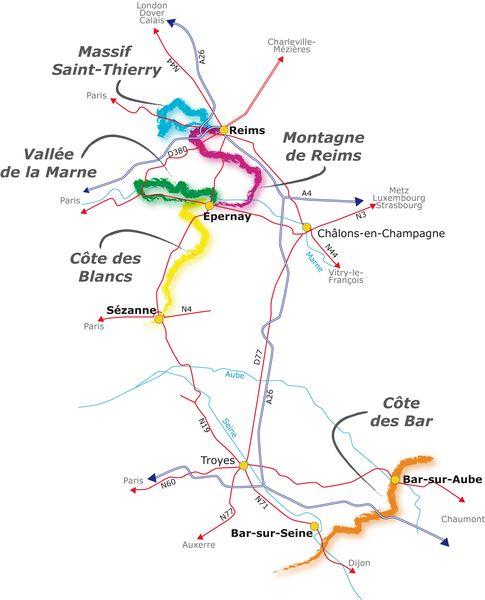
The Massif of Saint-Thierry and the Ardre Valley
In the Massif de St-Thierry, vineyards and forests form a beautiful case of greenery to the villages that are intimately related to the coronations of the kings of France.
From Reims, in the direction of Tinqueux, this section of the scenic Route du Champagne is delightfully picturesque. It starts with the visit of the Cathedral of Reims and the close by Tau Palace where the Cathedral Treasure and part of the original statuary can be found. In Reims, the magnificent Saint-Remi Basilica and its museum listed in the Unesco World Heritage are not to be missed.
Then the scenic Route du Champagnereaches Saint-Thierry which 12th century chapel has beautifully carved capitals. Further is the mill of Villers-Franqueux, then the beautiful mid-12th century church of Saint-SauveurHermonville. In Cauroy-les-Hermonville, the church (early 12th century) worth the visit for its paneled Romanesque nave and its porch “Champemois”; so does the 19th century private castle of Vaux-Varennes. Montigny-sur-Vesle houses the "Virgin’s Grotto" located 500m away from the village. The scenic Route du Champagnewinds among vineyards, market gardens and ancient peat bogs, along the Vesle Valley all the way to Jonchery-sur-Vesle.
After the Irval castle, the scenic Route du Champagnereaches Pévy, where the Romanesque church has a Gothic altar with a 15th century altarpiece. The village of Pevy also houses some interesting wash-houses and fountains and stone houses. In the charming village of Trigny, the scenic Route du Champagnewinds along the tiny streets.
Leaving the village of Chenay, the scenic Route du Champagneoffers a great view onto the valley and the cathedral of Reims. It passes near the amazing quarries of Châlons-sur-Vesle before reaching Gueux and ending in Reims.
Montagne de Reims and Parc Régional Naturel
The smooth mountainsides of the Montagne de Reims are one of the finest French vineyards. From either Reims or Epernay this section of the sign-posted scenic Route du Champagne goes to the heart of the ParcRégional Naturel (Regional Park for the preservation of the local species).
Before leaving Reims, the Museum Hotel Le Vergeur, the Museum of Fine Arts, the underground galleries of the city and three hundred year old vines are not to be missed! After a first stop in Gueux, the scenic Route du Champagne goes through Vrigny. The vineyards mingle with thousands of flowers in Coulommes-la-Montagne.
Further, on top of a hill is the Saint-Lié Chapel. From the hilltop the panorama onto the large plain of the Reims area allows to see in the distance the many churches among which the monumental one of Villedommange (12th-16th century) as well as those of Sacy, Chamery, and Sermiers that are in the heart of the “Petite Montagne” (small mountain).
The scenic Route du Champagne goes across the “Grande Montagne” (large mountain), realm of Pinot noir, and follows the edge of the “Parc Naturel Régional de la Montagne de Reims” (a protected natural area) with the remarkable village of Verzenay and Verzy, a very ancient wine growers village. With more than 1 000 beeches, the Forest of Verzy is the main World Reserve of beeches.
The scenic Route du Champagne winds its way between plains, vineyards, forests and stretches to Ambonnay, then Bouzy famous for its red wines. In Louvois, a 17th century private castle stands up in the middle of its park designed by Le Nôtre. The hilly road goes to Avenay-Val-d'Or and from there to Mutigny where the view onto Epernay and the surrounding villages is outstanding.
From Avenay-Val-d'Or, the scenic Route du Champagne offers another option to Mareuil-sur-Aÿ. At the entrance of the village is a very abrupt hillside covered with the vineyards of the “Clos des Goisses”, one of the rare vineyards in the Champagne area to be surrounded by walls.
This section of the scenic Route du Champagne ends in Epernay, capital of Champagne wines. The town may appear very busy but this is not taking into account quietness of the 100 kms of underground cellars where millions of bottles are lying. A whole world to be discovered!
The Marne Valley and heights of Epernay
Often overlooking the Valley, this section of the scenic Route du Champagneoffers wonderful views and opens the doors of its rich heritage. Starting in Epernay it follows the right bank of the Marne River, and comes back to Epernay along the left bank.
The Pinot Meunier vines stretch out as far as the eye can see and many villages, castles and churches are to found along the scenic roads of the Marne area. From Reims, this section of the scenic Route du Champagnegoes toward Epernay, going up to Champillon which offers amazing views onto the first hills of the “Côte des Blancs”. Following the “chemin du paradis” which meanders among the vineyards is but a short detour. Continuing across a forested plateau the itinerary soon goes back down to the charming village of Hautvillers and its renowned Benedictine Abbey hosting Don Perignon tomb.
On the right bank of the Marne River, in Cumières, it is possible to board the “Champagne Vallée” to discover the Marne Valley drifting down the stream.
The scenic Route du Champagnecontinues on the track to Damery where the 12th-13th century church, towering above the village, houses a 18th century Watteau’s painting (Virgin Mary and child). Towards Venteuilth itinerary offers a view on the castle of Boursault. It then goes across hilly vineyards, villages, fields and forests, to Binson-Orquigny and Reuil, offering a nice view over the valley in Chatillon-sur-Marne. Then, it reaches Dormans where the park of the Louis 13th castle is open to the public. The Memorial of the Marne Victories in Dormans offers a unique panorama on the region.
The scenic Route du Champagnenow follows the left bank of the Marne River to Festigny. On the way the timeless village of Oeuilly is a must see. There, the MaisonChampenoise, a rural museum, presents the winemakers daily life since the 18th century.
The nearby Château de Boursault proudly dominates the valley. In the village of Saint-Martin-d'Ablois, the shade of trees in the Soudron Park (open from April to October) offers a pleasant break.
Before returning to Epernay, the scenic Route du Champagnegoes along a fine collection of 18th century properties and houses in the village of Pierry.
The Côte des Blancs and the Coteaux du Sézannais
The Côte des Blancs is the birthplace of Chardonnay. The famously named villages are built on the hillside, in the shape of an amphitheater. The vineyards of the coteaux du Sézannais offer a charming bucolic landscape. From either Epernay or Villenauxe-la-Grande, this section of the scenic route du Champagne is enameled with historical records of great interest.
Between Epernay and Vertus, the Côte des Blancs (literally the hillsides of the white wines), is north-south oriented, leaning on the edge of the Brie plateau.
The route begins in Epernay, with the famous Avenue de Champagne. Going around the Mont Bernon via Chouilly it then goes down to Pierry where the chateau, warehouse and cellars date back to the 18th century and can be visited. The 12th century church of Chavot-Courcourt stands like an island in an ocean of vines.
The scenic route du Champagne leaves the village of Cuis and its lovely roman church and runs along the escarpments before reaching Cramant and the nearby hamlet of Avize adorned with frescoes – which by the way are quite common in the Champagne region. Next is Oger, one of the most beautiful villages of France, with a museum called “Musée des Traditions, de l'Amour et du Champagne” – all about tradition, love and… Champagne! In Vertus the itinerary follows the picturesque streets and goes along the 11th-12th century church of Saint-Martin and among many fountains. After Bergères-lès-Vertus, it passes near the Mont Aimé, and crosses the Champagnes plains before winding its way among the vines of Toulon-la-Montagne and Etoges, near the 12th century chateau-hotel.
Vineyards in Villevenard, swamp in Saint-Gond, particular wildelife in Oyes, view point in Mondement, and last the Petit Morin Valley give a glimpse of the turbulent past of the area.
The charming medieval town of Sézanne has kept many traces of its past as a market town. Not to be missed: the Saint-Denis church and the cloister of the hospital. The scenic route du Champagne passes through the Traconne forest and goes to Barbonne-Fayel. It then passes Chantemerle, then Villenauxe-la-Grande with its well-known ceramics and pottery. It ends with the ancient houses and the majestic altar of the Saint-Pierre et Saint-Paul church.
